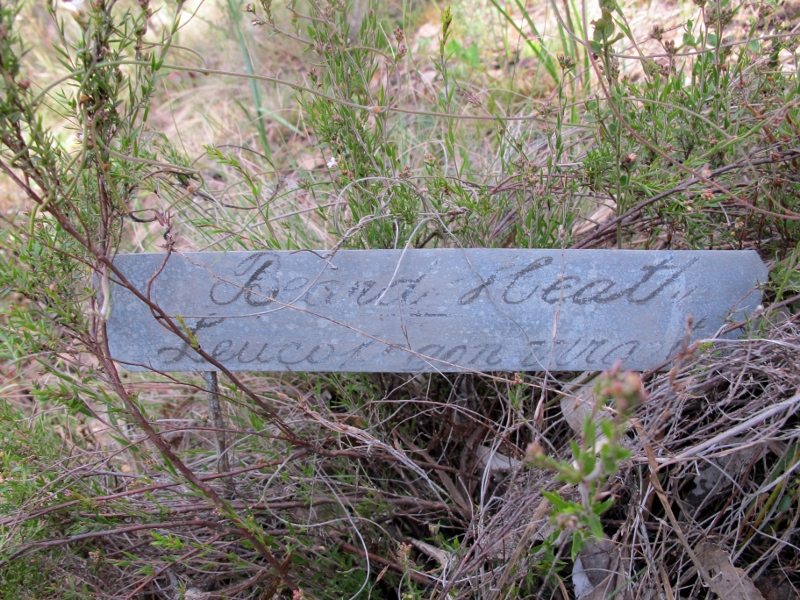At the junction of the Old Coach Road and the Fryers Ridge Road there’s an old fenced area, about 200 metres square. The fence isn’t in bad shape, but has been knocked down in a couple of places by falling tree branches, and tussocks in the enclosed area are clearly being grazed. Otherwise the vegetation in the enclosure is in pretty good shape.
Who put Who put up the fence? When?

This old metal tag is a sign that someone once took great care to identify plants in the Fryers exclusion plot…and the patch of Beard Heath it marks still survives, though a little bedraggled.
There have been a few initiatives in the past to protect patches of our bushland from overgrazing, mainly by sheep. One such was a proposal by Castlemaine Rotary in 1936 to establish wildflower sanctuaries around the shire. It seemed to run aground in the face of reluctance on the part of foresters to do anything about it. Could this fenced off area be the result of a community initiative which did get somewhere? We’d be interested in any informed answer.




 Click on image for info/order page
Click on image for info/order page Click on image for info/order page
Click on image for info/order page Click on image for info/order page
Click on image for info/order page





















I have had to dig into my records but I recall the FNCV conducted numerous excursions to this site dating back to the late 1800’s and a “Reserve” was later established. Members caught the train to Taradale then walked out the Old Coach Road for a day of botanising. The FNCV also had several spin off groups including Winifred Waddell’s Native Plants Preservation Society established n 1951. This group was instrumental in the establishment of a number of sanctuaries around the state. The sanctuaries were fenced to exclude rabbits and stock and ranged in size from 18 acres to small plots of 1/2 an acre. Their Annual Report for 1956 (I have a copy in front of me) describes the following under the heading New Sanctuaries.
“Taradale.- The Taradale-Fryerstown district is rich in colourful flora of the goldfields. The sanctuary provided by the Forests Commission on the Fryerstown Road protects a rare Beard-heath, Leucopogon biflorus. The census lists an attractive north-central plant association, also the Common Heath of Southern Victoria growing beside the Bendigo Wax-flower.”
I know the site well but do not believe the rare species remains but it does still exist in a gully to the south. It is now named Leucopogon fletcheri subsp. brevisepalus, the Twin-flower Beard-heath. The original name was incorrectly applied and is a NSW species
Many thanks for that info John. That’s a great piece of cultural history–and it shows how intrepid those field nats were.